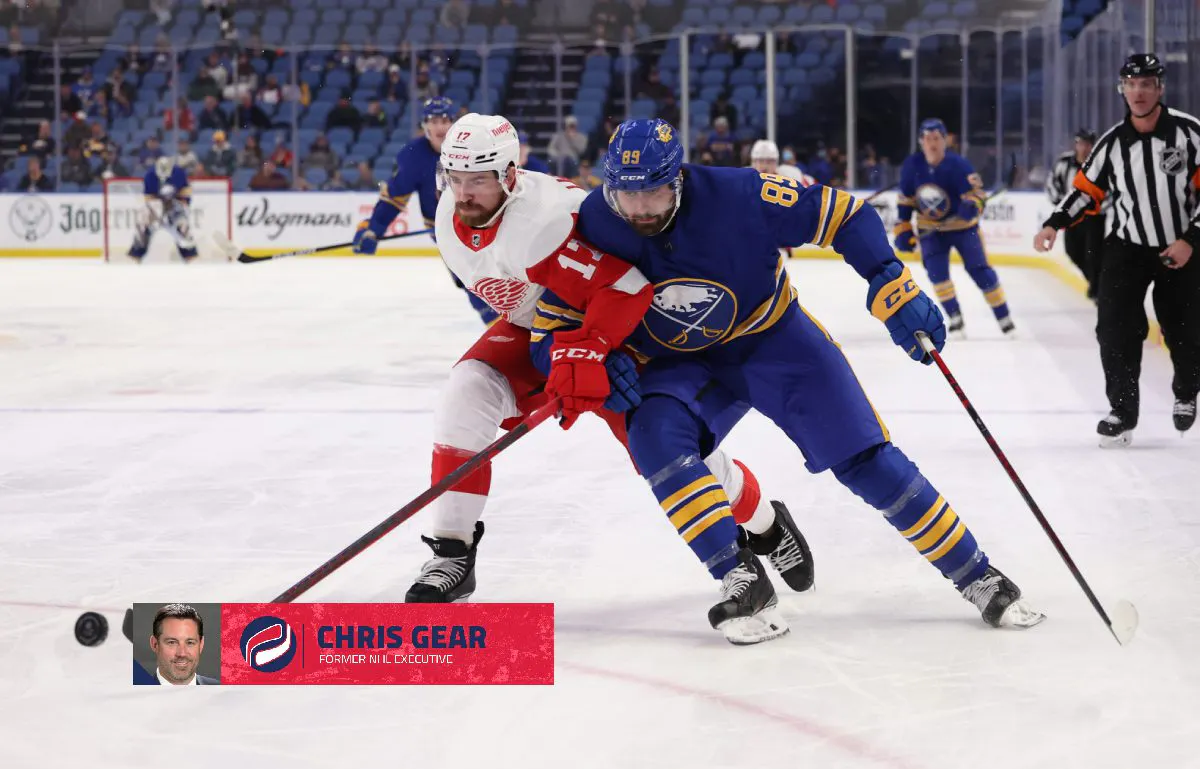Why the Buffalo Sabres and Detroit Red Wings won’t be Atlantic Division doormats next season

The end-of-season NHL standings over the last five years have been a bit like scenes out of Groundhog Day. As sure as Punxsutawney Phil would emerge to look for his shadow at the festival at Gobbler’s Knob each Feb. 2, the Buffalo Sabres and Detroit Red Wings would emerge as league cellar dwellers when the regular-season schedule wrapped.
A few other teams have taken their turns in the bottom third of the league standings over this period, including the Arizona Coyotes, Ottawa Senators and New Jersey Devils. However, the Sabres and Wings have been fixtures, stuck in the mud and spinning their wheels.
The 2021-22 season is about to close with each of them on the outside looking in again. However, both teams showed signs this year of putting the dark times behind them and stepping into the light. Though the eight playoff teams in the Eastern Conference this season will almost certainly remain competitive next year, there is bound to be at least one team that falls off the pace early and can’t recover. Think this year’s New York Islanders. If that happens, it’s not unreasonable to think the Sabres and Wings can be the ones pushing to take that spot in the tournament.
How did these teams stay in neutral for so long, and what’s different now?
Let’s start with the Sabres. Over the last 10 years, they have been as cold as a Buffalo winter. Their highest finish in the overall standings was 23rd, something they accomplished twice and also where they currently sit in 2021-22. Their other finishes were 31st (twice), 30th (twice), 25th, 26th, 27th and 28th. It’s an incredible run of futility.
Buffalo can’t even blame bad drafting for its plight. Since 2010, the Sabres have made 14 first-round picks, and they have hit on every single one of them in terms of that player becoming (or being on the verge of becoming) an NHL regular. The list includes Mark Pysyk, Joel Armia, Mikhail Grigorenko, Zemgus Girgensons, Rasmus Ristolainen, Nikita Zadorov, Sam Reinhart, Jack Eichel, Alexander Nylander, Casey Mittelstadt, Rasmus Dahlin, Dylan Cozens, Jack Quinn and Owen Power. Not a murderer’s row, but several players that would constitute high-end talent and no outright whiffs.
During that span, the Sabres also drafted Jake McCabe, Linus Ullmark, JT Compher, Cal Petersen, Brendan Lemieux, Rasmus Asplund and Victor Olofsson. The Sabres have been able to identify talent, but they just haven’t been able to keep or develop enough of the players they have selected. Whether it’s losing players through free agency or trading them away before they reach their ceilings, Buffalo just hasn’t been able to turn its strong annual draft position into an advantage.
Even Eichel, perhaps their most talented draft pick ever (with due deference paid to Gilbert Perreault, Alex Mogilny and Ryan Miller), eventually had to be shipped out in a deal with the Vegas Golden Knights, following a lack of alignment with management on just about everything, including how to treat his neck injury.
Storylines about lack of alignment and failure to develop players are starting to change in Buffalo. The Sabres have been rewarded for showing patience with Tage Thompson, who is closing in on 40 goals and 65 points and playing like he was shot out of a cannon this year. They also showed patience with two guys that have been the subject of much criticism for the lack of production they have shown in comparison to the contracts they signed: Kyle Okposo and Jeff Skinner. Both players have looked reinvigorated this year and have produced. Buffalo will need that to continue with Skinner, who is signed for five more years at an AAV of $9M.
Ironically, trading away its captain may have been the real jolt and turning point this franchise needed. Alex Tuch and Peyton Krebs, the two roster players acquired along with picks in the deal for Eichel, have made immediate impacts, while the rest of the team seems to have thrived and gelled without the Eichel media sideshow. From all indications, there seems to be a chemistry and sense of unity under head coach Don Granato, and it is translating into improved results.
The Sabres are 13-8-3 since March 1, and although the playoff races were largely over by then, the Sabres have beaten some excellent teams who had something to play for, in terms of seeding if nothing else.
With Power now joining Dahlin on the blueline and a good mix of young and veteran forwards, the Sabres are poised to leave their twenty-something finishes in the standings behind for the foreseeable future.
The Wings are another team long overdue for a breakout. After 25 consecutive playoff appearances between 1989-90 and 2015-16, the Wings have embarked on a six-year stretch where they have not finished higher than 25th overall (the place they currently occupy in 2021-22). The run of poor results includes the dreadful 2019-20 season during which they finished 17-49-5.
Unlike the Sabres, the Wings absolutely have to look at their drafting as a reason for their poor recent showing. Between 2012 and 2018, the only impact players selected by the Wings in any round were Anthony Mantha and Tyler Bertuzzi in 2013, Dylan Larkin in 2014 and Filip Hronek in 2016. Otherwise, there have been an awful lot of misses on the Red Wings’ draft boards. First-round picks during that stretch that have made the NHL but with very limited impact include Evgeny Svechnikov, Dennis Cholowski, Michael Rasmussen and Filip Zadina.
You simply can’t afford to have mediocre first-round draft results and expect to rise from the bottom of the league standings.
Zadina may still turn into a nice NHL player, but he won’t likely ever be a player of the magnitude of Quinn Hughes, the player Detroit passed on to take Zadina, despite Hughes playing under Detroit’s noses at University of Michigan.
Whatever ailed Detroit’s scouting for those years seems to have been a blip, as the Wings nailed their first-round selections in each of 2019 and 2020. In 2019, the Wings picked German defenseman Moritz Seider well above where experts predicted he would be selected. That proved to be a brilliant pick, as Seider has had an impressive first campaign that may very well earn him a Calder Trophy as top rookie.
In 2020, the year Detroit had the greatest odds to select first based on its 2019-20 finish, the lottery balls bounced in the wrong direction and dropped the Wings to the fourth overall pick. That may have been a blessing in disguise, because their pick Lucas Raymond may turn out to be the best player in a very strong 2020 Draft class.
The jury is still out on 2021 first-round pick Simon Edvinsson, who played in Sweden this season, but the emergence of Seider and Raymond has already changed the outlook for the Red Wings.
With 10 picks in the upcoming 2022 Draft and more cap space than most teams to perhaps make a few free-agent acquisitions, the future in Motown should be a much brighter one.
Whether Buffalo and/or Detroit can make it to the playoffs next year remains to be seen. But I would bet their doormat days are over.
____
Chris Gear joined Daily Faceoff in January after a 12-year run with the Vancouver Canucks, most recently as the club’s Assistant General Manager and Chief Legal Officer. Before migrating over to the hockey operations department, where his responsibilities included contract negotiations, CBA compliance, assisting with roster and salary cap management and governance for the AHL franchise, Gear was the Canucks’ vice president and general counsel.
Click here to read Gear’s other Daily Faceoff stories.
______

PointsBet Canada has officially launched in Ontario! Get a $25 free bet just for signing up right here!